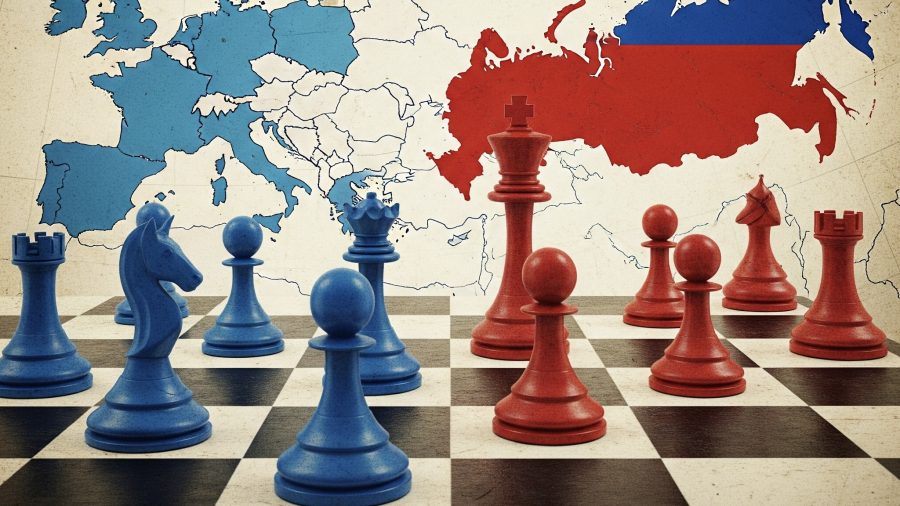Abstract
Looking at the situation, the United Kingdom’s 2025 Strategic Defence Review (SDR) projects a confident rationality: an “Integrated Force” designed to deter, fight, and win through “constant innovation at wartime pace” (Ministry of Defence, 2025, p. 14). Yet Moscow’s conduct in Ukraine has revealed a profoundly different strategic grammar. Russia behaves, in Ondřej Ditrych’s terms, as a bricoleur – an opportunistic tinkerer that stitches together ad hoc “assemblages” while actively cultivating contradictions to wrong-foot a rule-bound opponent (Ditrych, 2024, p. 2). This article argues that a defence posture optimised for elegant integration may prove brittle when confronted by such an adversary. It posits that Russia’s dialectical approach is designed to exploit the very linear logic that underpins Western military planning. By contrasting the systemic fragility of Russian bricolage, vividly exposed by the Wagner Group’s implosion, with the SDR’s search for institutional longevity, this analysis suggests that effective deterrence now requires the UK to supplement integration with a capacity for institutionalised improvisation. This ‘controlled bricolage’ is presented as a form of adaptive power, essential for reassuring allies and succeeding in an era of disorderly, attritional conflict.
1. A Strategy of Contradiction
To understand the contemporary threat is to look beyond conventional military net assessment and into an opponent’s strategic culture. Ondřej Ditrych (2024, p. 3) characterises the Russian state not as a grand strategist but as a bricoleur, a tinkerer that improvises solutions from a limited repertoire of available parts. This is more than mere opportunism; it is a dialectical method. It is comfortable with, and indeed actively cultivates, the very contradictions that would paralyse a Western staff college. Russia’s strategy often appears to be a pastiche of mutually exclusive signals: complaining of encirclement while expanding its territory, invoking international law while flouting it, and deploying high-tech weaponry alongside crudely adapted civilian technologies. This is not strategic incoherence but a feature designed to create a chaotic information environment, wrong-footing an adversary who seeks clarity and predictability.
The Wagner Group was, perhaps, the ultimate expression of this method. It was a composite entity that simultaneously functioned as a proxy military force, a resource-extraction enterprise, a political influence operation, and a vehicle for plausible deniability (Ditrych, 2024, p. 3). It allowed Moscow to project power into Africa and the Middle East in ways that circumvented the rules of state-on-state competition. Yet this bricolage has a breaking-point. Such ad hoc structures lack institutional resilience. Wagner’s spectacular implosion following Yevgeny Prigozhin’s 2023 mutiny was not the result of external pressure but of the unbearable internal frictions of the system that created it (Ditrych, 2024, p. 4). This reveals the core vulnerability of the bricoleur: a reliance on improvised, personality-driven structures that can shatter under systemic stress, a stark contrast to the West’s enduring, if cumbersome, search for institutional longevity.
2. The Limits of an Engineered Deterrence
The SDR’s answer to this disorderly world is a renewed drive for rational integration. It proposes a force “integrated by design” (Ministry of Defence, 2025, p. 15-16), directed by a new Military Strategic Headquarters and equipped via a streamlined Defence Investment Plan. The document is, in itself, a signal of intent, a blueprint for a logical, legible, and thereby deterring military machine. However, in applying this lens, it arguably misreads the nature of the challenge. As the RAND Corporation’s work on national power suggests, military effectiveness is not simply a function of material capabilities– the ships, tanks, and aircraft a nation possesses. It depends equally on the efficiency of the conversion process that turns those national resources into usable military power (Treverton and Jones, 2005, p. 18). Russian bricolage is, in essence, a high-speed, high-risk conversion strategy. The UK’s SDR, with its focus on creating new bureaucratic structures and processes, risks optimising its inventory of capabilities while neglecting the need for a truly agile conversion mechanism.
This creates a deterrence paradox, which plays out for multiple audiences. The first, and most obvious, is the adversary. As Keir Giles argues, Russia often discounts material symbols of Western strength, focusing instead on a perceived lack of political will and a hesitation to accept risk (Torun, 2024, p. 667, summarising Giles). A bricoleur state, seeking seams to exploit, is unlikely to be deterred by a show of conventional force that it believes will never be used in the ambiguous ‘sub-threshold’ where it prefers to operate. The second, and equally critical, audience is domestic and allied. Effective deterrence requires not only a credible threat but also the reassurance of one’s own public and partners that the nation can withstand and respond to shocks. This requires a resilient defence industrial base capable of surging production. The SDR acknowledges this, noting that a nation’s Armed Forces are only as strong as the industry behind them (Ministry of Defence, 2025, p. 7), but the deep-seated challenge of moving from peacetime efficiency to wartime industrial mass remains a critical constraint on the UK’s own risk appetite and, therefore, its credibility.
3. Towards an Elastic Architecture: Institutionalising Bricolage
If Russia’s strategic advantage lies in its tolerance for disorder, then an effective counter-strategy cannot lie solely in the imposition of a more perfect order. The UK must learn to fight fire with fire, supplementing its integrated blueprint with a capacity for institutionalised improvisation. This means cultivating a form of ‘controlled bricolage’ as a source of adaptive power. Treverton and Jones (2005, p. 11) noted two decades ago how the information technology revolution would inevitably move action away from slow-moving governments and “toward nimbler organisations.” The SDR’s proposal for an “expert Digital Warfighters group” (Ministry of Defence, 2025, p. 47-49) is a promising, if nascent, step in this direction. For this to become a genuine source of advantage, however, it must be treated not as a specialist enclave but as a guiding ethos for the entire force, empowering small teams at the tactical edge to experiment, adapt, and exploit opportunities at a speed the adversary cannot match.
This, in turn, requires a fundamental shift in the Ministry of Defence’s culture of procurement and risk. It necessitates an embrace of “good-enough” solutions that can be fielded rapidly, with iterative upgrades baked into the process, rather than pursuing perfect capabilities that risk arriving too late. Such an approach accepts that in a state of constant technological flux, some failure is inevitable and should be treated as an opportunity for accelerated learning. This is the logic behind the Royal Navy’s planned regulatory “sandbox” for autonomous systems (Ministry of Defence, 2025, p. 105-106), a concept that must be expanded across all domains. An elastic and adaptive force, capable of improvising under pressure, offers a more credible deterrent to a bricoleur than a rigid one, however powerful. It signals a capacity to endure, to adapt, and to respond effectively amid the very chaos the adversary seeks to create.
4. Conclusion
Arguably, a rationally designed and integrated force remains indispensable for the enduring demands of high-intensity warfare. Integration alone, however, is no longer sufficient. The central insight for UK defence is that an over-optimisation for elegant, systemic coherence can itself become a vulnerability when facing an opponent whose strategy is to weaponise disorder. Power in the 21st century is increasingly a function of adaptability. The challenge, therefore, is to create an architecture that is not only strong but also elastic; one that can, when necessary, fracture gracefully into many semi-autonomous nodes, each authorised to improvise within the commander’s intent. Deterrence means more than pure strength, it is the ability to adapt one’s defence to the changing strategic landscape.
Bibliography
Ditrych, O. (2024). DECONSTRUCTING RUSSIA’S BRICOLAGE TACTICS: Strategic insights for defeating the Kremlin. EUISS Brief 18. Paris: European Union Institute for Security Studies.
Ministry of Defence. (2025). Strategic Defence Review 2025: Making Britain Safer, Secure at Home, Strong Abroad. London: HM Government.
Torun, Z. (2024). Review of ‘Russia’s War on Everybody. And What it Means for You’, by Keir Giles. Europe-Asia Studies, 76(4), pp. 667-668.
Treverton, G. F. and Jones, S. G. (2005). Measuring National Power. Santa Monica, CA: RAND Corporation.


